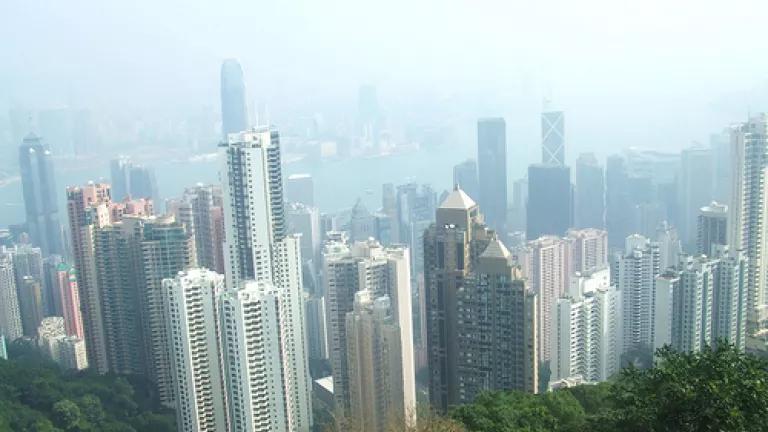
I traveled to Hong Kong last week and was greeted by a layer of smog. The city’s famous skyline was marred by haze, and the pollution in the air exceeded World Health Organization guidelines four out of the five days I was there. I loved exploring the city, but I felt fortunate to leave before I got the so-called Hong Kong cough triggered by dirty air.
Hong Kong isn’t the only metropolis struggling with air pollution. Harbin in Northeast China shut down schools, airports, and roads in October when smog reduced visibility to 10 yards. And last winter, 850 million people in Beijing and other Chinese cities experienced some of the worst air quality on record.
I remember when New York City had filthy air too. Groups like NRDC worked hard to hold polluters accountable. We cleaned up our skies and our economy continued to grow. Yet some lawmakers are trying to gut the safeguards that protect our health. I urge them all to go to Hong Kong for a few days.
Hong Kong’s hazy skies; pollution exceeded WHO guidelines 323 days this year.
Because air pollution doesn’t just ruin the view; it makes people sick and costs money. Hong Kong’s air pollution was linked to 3,600 deaths in 2011 and left the city with $1.4 billion in health care and productivity losses over five years. The American Chamber of Commerce in Hong Kong found that 40 percent of companies have trouble recruiting workers to the city because they don’t want to expose their families to polluted air.
No one wants their loved ones breathing dangerous pollution, and that’s why NRDC and our local partners are working to clean up the air in Hong Kong and other cities in China.
One of our main targets is dirty emissions from shipping. Hong Kong is the third busiest port in the world. Massive container ships account for Hong Kong’s largest source of particulate matter and nearly half of its sulfur dioxide—both linked to cancer, respiratory illness, and heart disease. More than 515 premature deaths a year have been directly attributed to sulfur dioxide pollution from oceangoing ships in the Pearl River Delta. Hong Kong sits right at the mouth of the Pearl River.
NRDC has pioneered programs to reduce port pollution in the United States. We helped the Ports of Los Angeles and Long Beach, for instance, cut sulfur emissions by more than 85 percent, reducing health risks for tens of thousands of people living nearby. We then pushed for similar breakthroughs across the country. Working with the government and private sector, we helped create an Emissions Control Area that will cut particulate pollution from ships at all U.S. ports and off U.S. coasts by more than 85 percent by 2020.
Now we are sharing our experience with local partners to help Hong Kong clean up its port—and lead the way for neighboring ports in Shenzhen and Guangzhou. We plan to use a number of available solutions such as cleaner burning fuels and on-shore power to quickly curb pollution right now. But ultimately, we want to help the region establish an Emission Control Area to cover the entire Pearl River Delta, one of the most densely populated areas on earth.
At the same time, we are also looking to China’s national efforts to clean up its air, like the recent Atmospheric Pollution Prevention Action Plan. With strong targets and consistent enforcement, these efforts can dramatically improve the health of the nation.
We have seen it happen here in the United States. Our Clean Air Act saves tens of thousands of lives every year. House Republican efforts to roll back these standards would take us back to darker, dirtier days. I hope that each time I return to Hong Kong, the skies look more like New York City today and not the other way around.
Photo credit: xlibber
